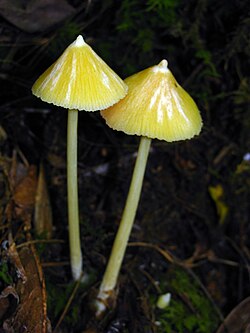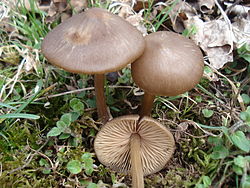A




- Entoloma abbreviatipes (Largent) Noordel. & Co-David (2009)
- Entoloma aberrans E. Horak (1973)
- Entoloma abnorme (Peck) Noordel. (2008)
- Entoloma abortivum (Berk. & M.A. Curtis) Donk (1949)
- Entoloma accline (Britzelm.) Sacc. (1887)
- Entoloma accola (Britzelm.) Sacc. (1887)
- Entoloma acericola (Murrill) Blanco-Dios (2017)
- Entoloma aciculocystis (Romagn. & Gilles) Noordel. & Co-David (2009)
- Entoloma acidophilum Arnolds & Noordel. (1979)
- Entoloma acuferum (Romagn. & Gilles) Noordel. & Co-David (2009)
- Entoloma acuminatum E. Horak (1980)
- Entoloma acuticystidiosum E. Horak (1973)
- Entoloma acutipallidum E. Horak & Cheype (2010)
- Entoloma acutipes Largent (1994)
- Entoloma acutoconicum (Hongo) E. Horak (1976)
- Entoloma acutomycenoides Eyssart. & Buyck (2014)
- Entoloma acutoumbonatum (Largent) Noordel. & Co-David (2009)
- Entoloma acutum (Romagn. & Gilles) Noordel. & Co-David (2009)
- Entoloma adalbertii Romagn. (1987)
- Entoloma adirondackense Murrill (1917)
- Entoloma adnatifolium (Murrill) Blanco-Dios (2015)
- Entoloma aeruginosum Hiroë (1939)
- Entoloma aethiops (Scop.) G. Stev. (1962)
- Entoloma affine (Kauffman) Blanco-Dios (2017)
- Entoloma africanum (Maire) Blanco-Dios (2017)
- Entoloma afrum (Pegler) Noordel. & Co-David (2009)
- Entoloma aimeae Blanco-Dios (2015)
- Entoloma alabamense (Murrill) Hesler (1967)
- Entoloma alachuanum Murrill (1941)
- Entoloma albatum Hesler (1967)
- Entoloma albellum (Romagn.) Singer (1986)
- Entoloma albidiforme Murrill (1945)
- Entoloma albidocoeruleum G.M. Gates & Noordel. (2007)
- Entoloma albidoquadratum Manim. & Noordel. (2006)
- Entoloma albidosimulans G.M. Gates & Noordel. (2007)
- Entoloma albidum Murrill (1917)
- Entoloma albinellum (Peck) (1967)
- Entoloma albipes Hesler (1967)
- Entoloma albivellum (Romagn. & Gilles) Noordel. & Co-David (2009)
- Entoloma alboconicum Dennis (1961)
- Entoloma albocrenulatum E. Horak (1980)
- Entoloma alboflavidum Rick (1930)
- Entoloma albofumeum Hesler (1967)
- Entoloma albogracile E. Horak (1976)
- Entoloma albogranulosum Noordel. & Hauskn. (2002)
- Entoloma albogriseum (Peck) Redhead (1979)
- Entoloma albomagnum G.M. Gates & Noordel. (2007)
- Entoloma albomurinum (Romagn. & Gilles) Noordel. & Co-David (2009)
- Entoloma alboproximum (Largent, Aime & T.W. Henkel) Mešić & Tkalčec (2016)
- Entoloma alboroseum (Romagn. & Gilles) Noordel. & Co-David (2009)
- Entoloma albosericeum Hesler (1974)
- Entoloma alboserrulatum (Rick) Blanco-Dios (2017)
- Entoloma albostrigosum (Largent & Abell-Davis) Blanco-Dios (2015)
- Entoloma albosulcatum Corner & E. Horak (1980)
- Entoloma albotomentosum Noordel. & Hauskn. (1989)
- Entoloma alboumbonatum Hesler (1967)
- Entoloma album Hiroë (1939)
- Entoloma alcalinum Murrill (1917)
- Entoloma alcedicolor Arnolds & Noordel. (2004)
- Entoloma aliquantulum E. Horak (1980)
- Entoloma alissae (Largent & Bergemann) Blanco-Dios (2016)
- Entoloma alium Corner & E. Horak (1980)
- Entoloma alliodorum Esteve-Rav., E. Horak & A. Ortega (2003)
- Entoloma allochroum Noordel. (1982)
- Entoloma allosericellum Noordel. (1988)
- Entoloma allospermum Noordel. (1985)
- Entoloma almeriense J. Carbó, F. Caball., Vila & Català (2014)
- Entoloma alnetorum Monthoux & Röllin (1988)
- Entoloma alnicola Noordel. & Polemis (2008)
- Entoloma alnobetulae (Kühner) Noordel. (1981)
- Entoloma alpicola (J. Favre) Bon & Jamoni (1981)
- Entoloma alpinum Xiao L. He, W.H. Peng & B.C. Gan (2015)
- Entoloma altaicum O.V. Morozova, Reschke, Noordel. & Ageev (2022)
- Entoloma altissimum (Massee) E. Horak (1976)
- Entoloma alutaceum Murrill (1917)
- Entoloma alutae E. Horak (1980)
- Entoloma alvarense Noordel. & Vauras (2004)
- Entoloma amarum Noordel. & G.M. Gates (2012)
- Entoloma ambiguum (Romagn. & Gilles) Noordel. & Co-David (2009)
- Entoloma ambrosium (Quél.) Noordel. (1980)
- Entoloma ameides (Berk. & Broome) Sacc. (1887)
- Entoloma amicorum Noordel. (1987)
- Entoloma amistadosericellum Reschke & Noordel. (2022)
- Entoloma ammophilum G.M. Jansen, Dima, Noordel. & Vila (2021)
- Entoloma amplisporum Corner & E. Horak (1980)
- Entoloma amygdalinum Noordel. (1987)
- Entoloma anamikum Manim., A.V. Joseph & Leelav. (1995)
- Entoloma anastomosans (Rick) Raithelh. (1991)
- Entoloma anatinum (Lasch) Donk (1949)
- Entoloma andersonii (Mazzer) Noordel. & Co-David (2009)
- Entoloma andinum Dennis (1961)
- Entoloma angulatum (Cleland) Grgur. (1997)
- Entoloma angustifolium Murrill (1917)
- Entoloma angustispermum Noordel. & O.V. Morozova (2010)
- Entoloma angustisporum (Romagn. & Gilles) Noordel. & Co-David (2009)
- Entoloma anisatum Arnolds (2015)
- Entoloma anisothrix (Romagn. & Gilles) Noordel. & Co-David (2009)
- Entoloma anodinum Vila, Carbó, Valero, Reschke & Noordel. (2021)
- Entoloma anthracinellum (M. Lange) Noordel. (1984)
- Entoloma anthracinum (J. Favre) Noordel. (1981)
- Entoloma antillancae E. Horak (1978)
- Entoloma apiculatum (Fr.) Noordel. (1981)
- Entoloma appalachianense Hesler (1967)
- Entoloma appendiculatum E. Horak (1980)
- Entoloma applanatum (Romagn. & Gilles) Noordel. & Co-David (2009)
- Entoloma appositivum (Britzelm.) Sacc. (1887)
- Entoloma appositum (Britzelm.) Sacc. (1910)
- Entoloma approximatum (Largent) Noordel. & Co-David (2009)
- Entoloma apressum (Largent) Blanco-Dios (2024)
- Entoloma aprile (Britzelm.) Sacc. (1887)
- Entoloma arachnoideus (Berk. & M.A. Curtis) Singer (1986)
- Entoloma aranense F. Caball. & Vila (2013)
- Entoloma araneosum (Quél.) M.M. Moser (1978)
- Entoloma arcanum Reschke & Noordel. (2022)
- Entoloma arcuatum (Romagn. & Gilles) Noordel. & Co-David (2009)
- Entoloma ardosiacum (Bull.) Quél. (1872)
- Entoloma argenteolanatum (T.J. Baroni, Perd.-Sánch. & S.A. Cantrell) Noordel. & Co-David (2009)
- Entoloma argenteostriatum Arnolds & Noordel. (1979)
- Entoloma argentinense (Speg.) Blanco-Dios (2015)
- Entoloma argentinum (Speg.) E. Horak (1978)
- Entoloma argillaceum O.V. Morozova, Reschke, Corriol, Noordel., Zvyagina, E.F. Malysheva & Svetash. (2022)
- Entoloma argus O.V. Morozova, E.S. Popov, A.V. Alexandrova & Noordel. (2022)
- Entoloma argyropelle (Pegler) Courtec. & Fiard (2004)
- Entoloma argyropus (Alb. & Schwein.) P. Kumm. (1871)
- Entoloma arion O.V. Morozova, E.S. Popov, T.H.G. Pham & Noordel. (2022)
- Entoloma aripoanum Dennis (1953)
- Entoloma armoricanum Hériveau & Courtec. (1995)
- Entoloma aromaticum E. Horak (1973)
- Entoloma arvigenum Corner & E. Horak (1980)
- Entoloma asperum E. Ludw., Hensel & M. Huth (2007)
- Entoloma asprelloides G. Stev. (1962)
- Entoloma asprellopsis G.M. Gates & Noordel. (2009)
- Entoloma asprellum (Fr.) Fayod (1889)
- Entoloma assiduum Vila, Reschke, Corriol, Polemis & Loizides (2021)
- Entoloma assimulatum Corner & E. Horak (1980)
- Entoloma assularum (Berk. & M.A. Curtis) Hesler (1967)
- Entoloma asterospermum (Romagn. & Gilles) Noordel. & Co-David (2009)
- Entoloma asterosporum (Coker & Couch) T.J. Baroni & Matheny (2011)
- Entoloma atlanticum G. Tassi (2003)
- Entoloma atrellum E. Horak (1973)
- Entoloma atricolor O.V. Morozova, Noordel., E.S. Popov & A.V. Alexandrova (2020)
- Entoloma atrifucatum (Largent) Noordel. & Co-David (2009)
- Entoloma atripes (Dennis) E. Horak (1978)
- Entoloma atrobrunneum Murrill (1917)
- Entoloma atrocoeruleum Noordel. (1987)
- Entoloma atroenigmaticum Noordel. & Hauskn. (2002)
- Entoloma atrofissuratum Noordel. & Wölfel (2001)
- Entoloma atrogriseum Largent (1994)
- Entoloma atromadidum A.M. Ainsw. & B. Douglas (2018)
- Entoloma atromarginatum (Romagn. & J. Favre) Zschiesch. (1984)
- Entoloma atropapillatum (Karstedt & Capelari) Blanco-Dios (2020)
- Entoloma atropellitum (J. Favre) Bon & Courtec. (1987)
- Entoloma atropileatum Dennis (1961)
- Entoloma atrosericeum (Kühner) Noordel. (1981)
- Entoloma atrosquamosum (Murrill) Hesler (1967)
- Entoloma atrostipitatum (Henn.) Blanco-Dios (2017)
- Entoloma atrovelutinum (Romagn. & Gilles) Noordel. & Co-David (2009)
- Entoloma atroviolaceum (Romagn.) Noordel. & Co-David (2009)
- Entoloma atrum (Hongo) Hongo (2010)
- Entoloma atypicum (E. Horak) Noordel. & Co-David (2009)
- Entoloma aurantiacum Z.S. Bi (1986)
- Entoloma aurantioalbum Corner & E. Horak (1976)
- Entoloma aurantioalpinum Armada, Vila, Bellanger, Noordel., Krisai & Dima (2022)
- Entoloma aurantiobrunneum Hesler (1967)
- Entoloma aurantiolabes G.M. Gates & Noordel. (2007)
- Entoloma aurantioquadratum C.K. Pradeep & K.B. Vrinda (2012)
- Entoloma aurantiovirescens Reschke, Lotz-Winter & Noordel. (2022)
- Entoloma aurantipes E. Horak (1980)
- Entoloma aurantium (Manim. & Leelav.) Manim., A.V. Joseph & Leelav. (1995)
- Entoloma aureocrinitum (E. Horak) Blanco-Dios (2015)
- Entoloma aurorae-borealis Noordel., Weholt, Eidissen & Lorås (2018)
- Entoloma australe (Murrill) Hesler (1967)
- Entoloma australiense Blanco-Dios (2015)
- Entoloma austriacum Courtec. (1993)
- Entoloma austroanatinum (Singer) E. Horak (1978)
- Entoloma austronitens Noordel. & G.M. Gates (2012)
- Entoloma austroprunicolor G.M. Gates & Noordel. (2007)
- Entoloma austrorhodocalyx G.M. Gates & Noordel. (2007)
- Entoloma austroroseum G.M. Gates & Noordel. (2007)
- Entoloma austrosarcitulum Noordel. & G.M. Gates (2013)
- Entoloma autumnale Velen. (1940)
- Entoloma avellaneosquamosum Hesler (1967)
- Entoloma avellaneum Murrill (1917)
- Entoloma avellanicolor (Romagn. & Gilles) Noordel. & Co-David (2009)
- Entoloma avilanum (Dennis) E. Horak (1976)
- Entoloma azureocystidiatum Noordel. & Hauskn. (2015)
- Entoloma azureopallidum Corriol (2016)
- Entoloma azureosquamulosum Xiao L. He & T.H. Li (2012)
- Entoloma azureostipes E. Horak (1980)
- Entoloma azureoviride E. Horak & Singer (1982)
- Entoloma azureum (Largent) Noordel. & Co-David (2009)

















